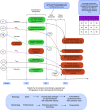Positive Bubble Study in Severe COVID-19 Indicates the Development of Anatomical Intrapulmonary Shunts in Response to Microvascular Occlusion
- PMID: 32997512
- PMCID: PMC7874427
- DOI: 10.1164/rccm.202008-3186LE
Positive Bubble Study in Severe COVID-19 Indicates the Development of Anatomical Intrapulmonary Shunts in Response to Microvascular Occlusion
Figures

Comment in
-
Reply to Cherian et al.: Positive Bubble Study in Severe COVID-19 Indicates the Development of Anatomical Intrapulmonary Shunts in Response to Microvascular Occlusion.Am J Respir Crit Care Med. 2021 Jan 15;203(2):265-266. doi: 10.1164/rccm.202009-3404LE. Am J Respir Crit Care Med. 2021. PMID: 32997507 Free PMC article. No abstract available.
Comment on
-
Pulmonary Vascular Dilatation Detected by Automated Transcranial Doppler in COVID-19 Pneumonia.Am J Respir Crit Care Med. 2020 Oct 1;202(7):1037-1039. doi: 10.1164/rccm.202006-2219LE. Am J Respir Crit Care Med. 2020. PMID: 32757969 Free PMC article. No abstract available.
References
Publication types
LinkOut - more resources
Full Text Sources
Other Literature Sources

